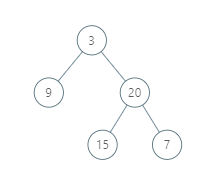题目¶
原题地址:https://leetcode.com/problems/vertical-order-traversal-of-a-binary-tree/
Given a binary tree, return the vertical order traversal of its nodes values.
For each node at position (X, Y), its left and right children respectively will be at positions (X-1, Y-1) and (X+1, Y-1).
Running a vertical line from X = -infinity to X = +infinity, whenever the vertical line touches some nodes, we report the values of the nodes in order from top to bottom (decreasing Y coordinates).
If two nodes have the same position, then the value of the node that is reported first is the value that is smaller.
Return an list of non-empty reports in order of X coordinate. Every report will have a list of values of nodes.
Example 1:
Input: [3,9,20,null,null,15,7] Output: [[9],[3,15],[20],[7]] Explanation: Without loss of generality, we can assume the root node is at position (0, 0): Then, the node with value 9 occurs at position (-1, -1); The nodes with values 3 and 15 occur at positions (0, 0) and (0, -2); The node with value 20 occurs at position (1, -1); The node with value 7 occurs at position (2, -2).
Example 2:

Input: [1,2,3,4,5,6,7] Output: [[4],[2],[1,5,6],[3],[7]] Explanation: The node with value 5 and the node with value 6 have the same position according to the given scheme. However, in the report "[1,5,6]", the node value of 5 comes first since 5 is smaller than 6.
Note:
- The tree will have between 1 and 1000 nodes.
- Each node's value will be between 0 and 1000.
解法¶
计算每个节点的 (x, y) 坐标,然后按 x 轴的值排序, 遍历排序后的结果,x 轴值相等的节点在同一条垂直线上可以归为一组。
这个方法的 Python 代码类似下面这样:
# Definition for a binary tree node.
# class TreeNode:
# def __init__(self, val=0, left=None, right=None):
# self.val = val
# self.left = left
# self.right = right
class Solution:
def verticalTraversal(self, root):
self._positions = []
self._collect_positions(root, 0, 0)
vals = []
last_x = -1001
for x, y, val in sorted(self._positions):
# x 轴值相同的归为一组
if x != last_x:
vals.append([])
last_x = x
vals[-1].append(val)
return vals
def _collect_positions(self, root, x, y):
if root is None:
return
self._positions.append((x, y, root.val))
# 之所以是 y + 1 而不是 y - 1 是为了实现排序后低层级的在前面
self._collect_positions(root.left, x - 1, y + 1)
self._collect_positions(root.right, x + 1, y + 1)

Comments